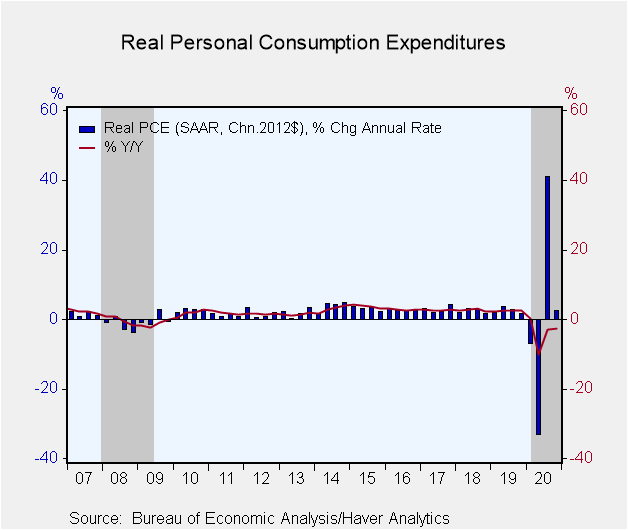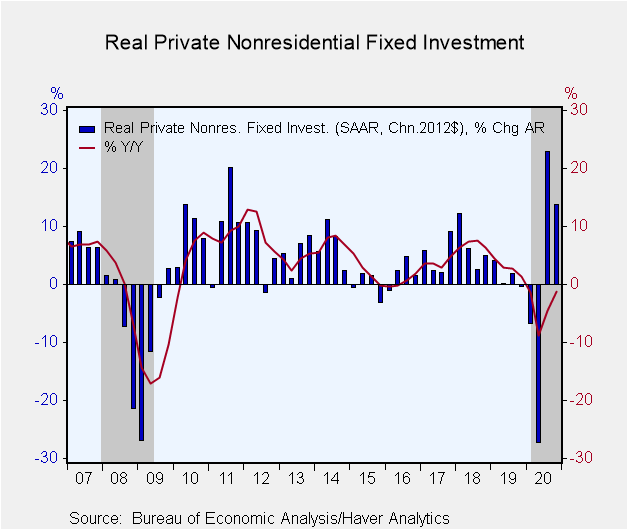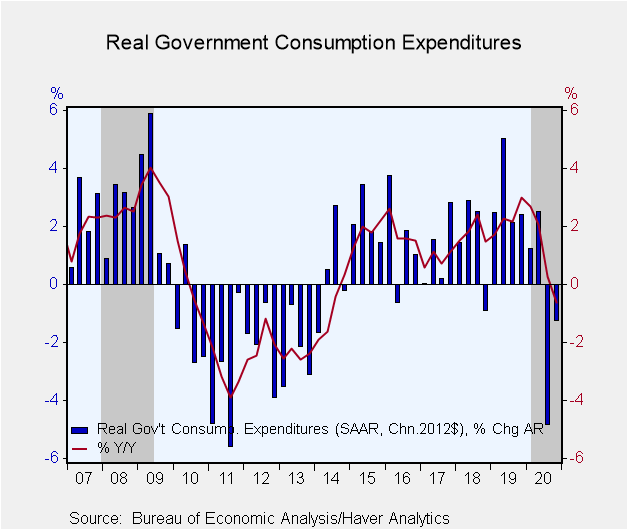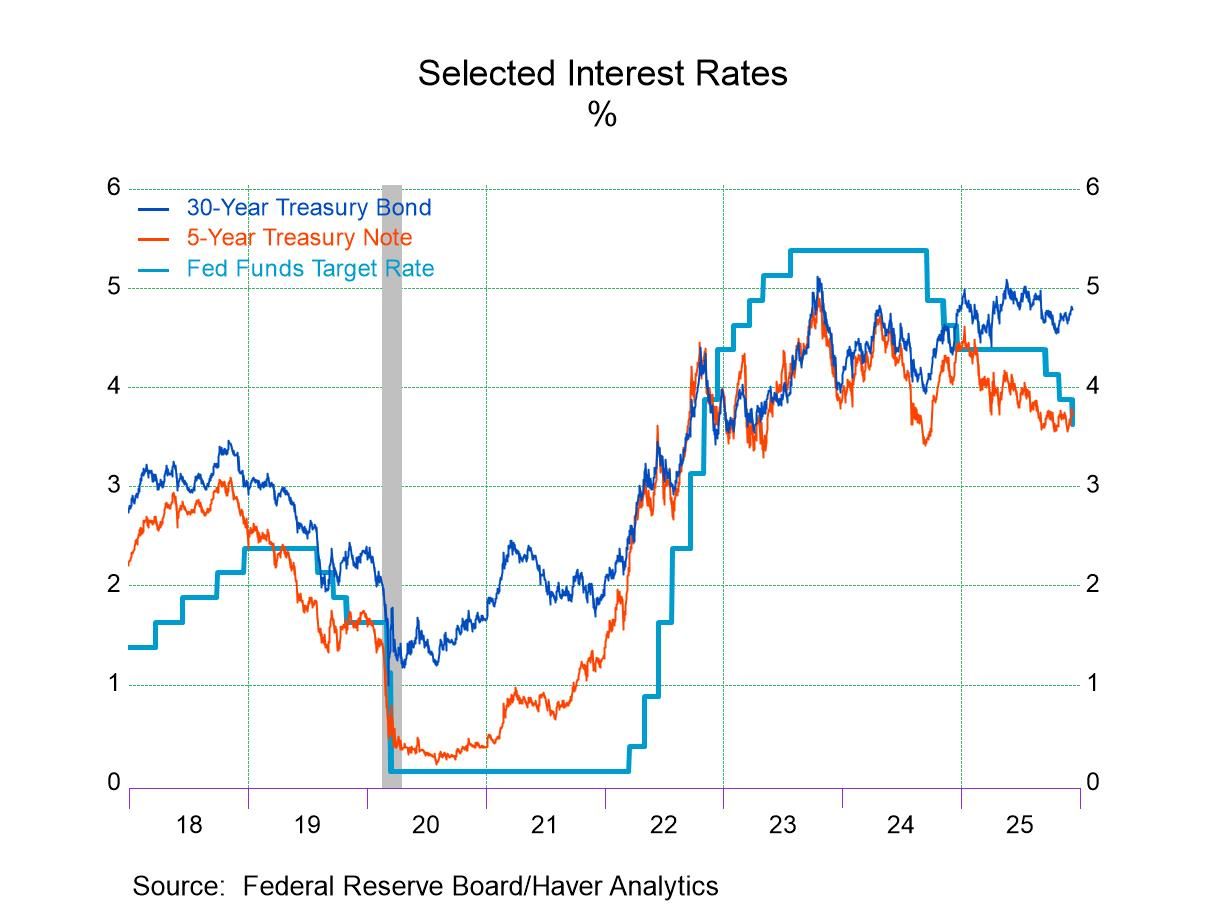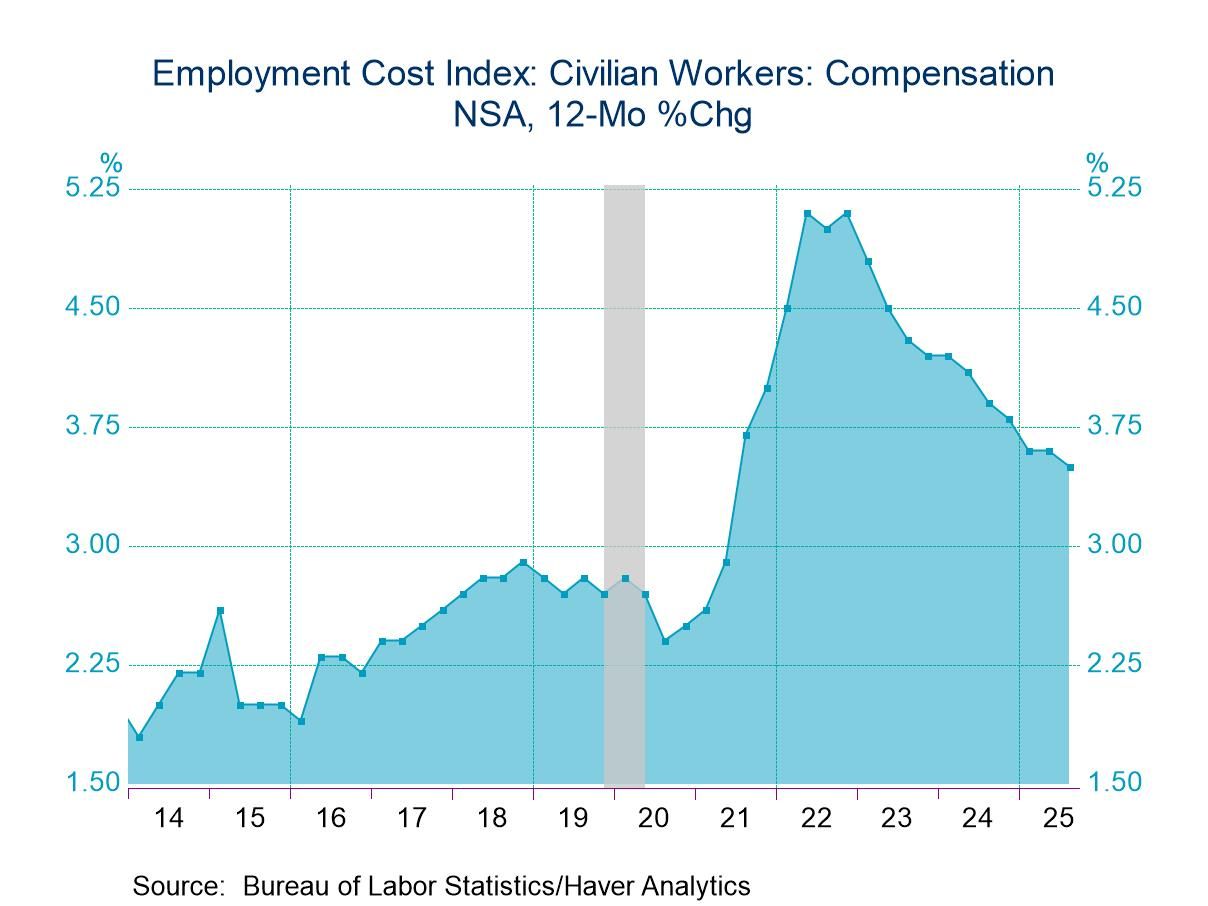 Global| Jan 28 2021
Global| Jan 28 2021U.S. GDP Growth in Q4'20 Weakens
by:Tom Moeller
|in:Economy in Brief
Summary
• Slower GDP growth reflects broad-based component weakening. • Decline in activity during 2020 is largest of post-WWII period. • Price gain eases in Q4. Recovery from the Q2'20 downturn in economic activity is continuing at a [...]
• Slower GDP growth reflects broad-based component weakening.
• Decline in activity during 2020 is largest of post-WWII period.
• Price gain eases in Q4.
Recovery from the Q2'20 downturn in economic activity is continuing at a moderate pace. Real GDP rose 4.0% (SAAR) during Q4'20 (-2.5% y/y) following a record 33.4% rise during Q3. A 4.3% advance had been expected in the Action Economics Forecast Survey. Combined with declines during Q1 and Q2, GDP stood 2.5% below the end of 2019.
Inventory accumulation added 1.0 percentage points to growth last quarter after adding 6.6 points in Q3. Foreign trade deficit deterioration subtracted 1.5 percentage points from growth. Exports rose 22.0% (-11.0% y/y) following a 59.6% rise while imports strengthened 29.5% (-0.6% y/y) after surging 93.0%.
Domestic final sales increased 4.4% (-1.5% y/y) following a 29.8% Q3 gain which recovered the prior quarter's decline. Consumer spending rose 2.5% (-2.6% y/y) following a 41.0% rebound and a 33.2% Q2 decline. Durable goods spending was fairly steady (11.9% y/y) after increasing 82.7% in Q3 as motor vehicle buying increased 3.7% (7.4% y/y) after a 77.6% surge in Q3. Home furnishings buying fell 5.6% (+8.9% y/y) after a roughly two-thirds gain. Recreational goods purchases fell 2.4% (+21.4% y/y) after surging 52.1% in Q3. Nondurable goods spending eased 0.7% (+4.3% y/y) following a 31.1% increase. Food & beverage spending declined 2.5% (+6.2% y/y) following a 5.5% gain. Apparel purchases rose 2.3% (-0.7% y/y) after surging 182.8%. Gasoline & oil spending weakened 3.9% (-10.2% y/y) after surging 88.4% in Q3. Outlays on services increased 4.0% (-6.8% y/y) following a 38.0% Q3 increase. Hotel & restaurant expenditures weakened 7.7% (-21.3% y/y) after recovering 206.3% in Q3. That followed two quarters of sharp decline. Spending on recreation services rose 12.3% (-32.9% y/y) after surging 225.0%. Health care outlays rose 12.4% (-4.5% y/y) following a 90.8% rise.
Nonresidential fixed investment grew 13.8% (-1.3% y/y) following a 22.9% rebound from three quarters of decline. Building investment grew 3.0% (-14.1% y/y) following four straight quarters of decline. Equipment investment surged one-quarter (3.4% y/y) after rising slightly more than two-thirds. Investment in intellectual property products rose 7.5% (1.4% y/y), about as it did in Q3.
Residential investment increased by one-third (13.7% y/y) following a two-thirds increase.
The 1.2% decline (-0.6% y/y) in government spending last quarter followed a 4.8% drop. State and local government spending fell 1.7% (-2.5% y/y), the third consecutive quarterly shortfall. A 0.5% easing (+2.5% y/y) in federal government spending followed a 6.2% Q3 fall. Despite the overall decline, defense spending improved 5.0% (2.9% y/y). Nondefense outlays fell 8.4% (+1.8% y/y).
The increase in the GDP price index moderated to 2.0% (1.3% y/y) after rising 3.5% in Q3. The PCE price index gained a lessened 1.5% (1.2% y/y), roughly half the Q3 increase. The price index less food & energy also moderated to 1.4%, both q/q and y/y, from 3.4% in Q3. The business fixed investment price index posted another weak increase, up 0.4% (0.6% y/y). The residential investment price index strengthened 6.0% (4.6% y/y) after rising 9.5% and the government sector price index rose 2.8% (1.3% y/y), about as it did in Q3.
The GDP figures can be found in Haver's USECON and USNA database. USNA contains virtually all of the Bureau of Economic Analysis' detail in the national accounts. Both databases include tables of the newly published not seasonally adjusted data. The Action Economics consensus estimates can be found in AS1REPNA.
Baby Boomers vs. Millennials Through Monetary Policy from the Federal Reserve Bank of Philadelphia can be found here.
| Chained 2012 $ (%, AR) | Q4'20 (1st Estimate) | Q3'20 | Q2'20 | Q4'20 Y/Y | 2020 | 2019 | 2018 |
|---|---|---|---|---|---|---|---|
| Gross Domestic Product | 4.0 | 33.4 | -31.4 | -2.5 | -3.5 | 2.2 | 3.0 |
| Inventory Effect (%-point) | 1.0 | 6.6 | -3.5 | -0.3 | -0.3 | 0.0 | 0.2 |
| Final Sales | 3.0 | 25.9 | -28.1 | -2.7 | -2.9 | 2.2 | 2.8 |
| Foreign Trade Effect (%-point) | -1.5 | -3.2 | 0.6 | -1.2 | -0.2 | -0.1 | -0.2 |
| Domestic Final Sales | 4.4 | 29.8 | -27.1 | -1.5 | -2.7 | 2.3 | 3.0 |
| Demand Components | |||||||
| Personal Consumption Expenditure | 2.5 | 41.0 | -33.2 | -2.6 | -3.9 | 2.5 | 2.7 |
| Nonresidential Fixed Investment | 13.8 | 22.9 | -27.2 | -1.3 | -3.7 | 2.5 | 6.9 |
| Residential Investment | 33.5 | 63.0 | -35.5 | 13.7 | 4.2 | -0.1 | -0.6 |
| Government Spending | -1.2 | -4.8 | 2.5 | -0.6 | 0.4 | 3.0 | 1.8 |
| Chain-Type Price Index | |||||||
| GDP | 2.0 | 3.5 | -1.8 | 1.3 | 1.2 | 1.8 | 2.4 |
| Personal Consumption Expenditure | 1.5 | 3.7 | -1.6 | 1.2 | 1.2 | 1.5 | 2.1 |
| Less Food & Energy | 1.4 | 3.4 | -0.8 | 1.4 | 2.4 | 1.7 | 2.0 |
| Nonresidential Investment | 0.4 | 0.1 | 0.8 | 0.6 | 0.5 | 1.3 | 0.9 |
| Residential Investment | 6.0 | 9.5 | 1.0 | 4.6 | 3.3 | 2.8 | 5.6 |
Tom Moeller
AuthorMore in Author Profile »Prior to joining Haver Analytics in 2000, Mr. Moeller worked as the Economist at Chancellor Capital Management from 1985 to 1999. There, he developed comprehensive economic forecasts and interpreted economic data for equity and fixed income portfolio managers. Also at Chancellor, Mr. Moeller worked as an equity analyst and was responsible for researching and rating companies in the economically sensitive automobile and housing industries for investment in Chancellor’s equity portfolio. Prior to joining Chancellor, Mr. Moeller was an Economist at Citibank from 1979 to 1984. He also analyzed pricing behavior in the metals industry for the Council on Wage and Price Stability in Washington, D.C. In 1999, Mr. Moeller received the award for most accurate forecast from the Forecasters' Club of New York. From 1990 to 1992 he was President of the New York Association for Business Economists. Mr. Moeller earned an M.B.A. in Finance from Fordham University, where he graduated in 1987. He holds a Bachelor of Arts in Economics from George Washington University.



